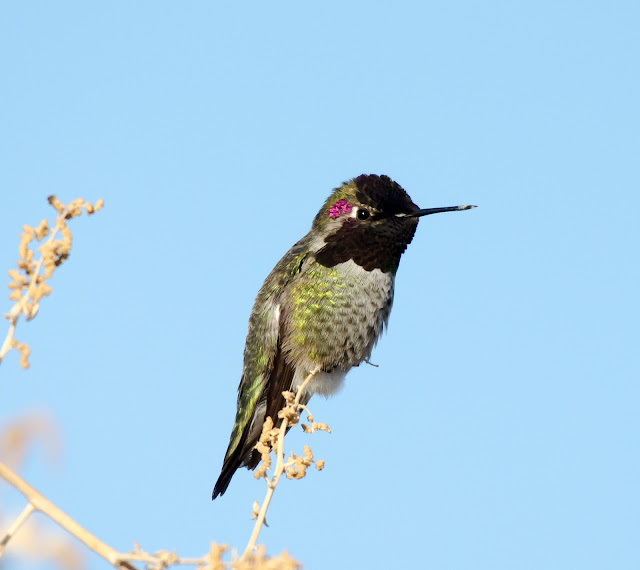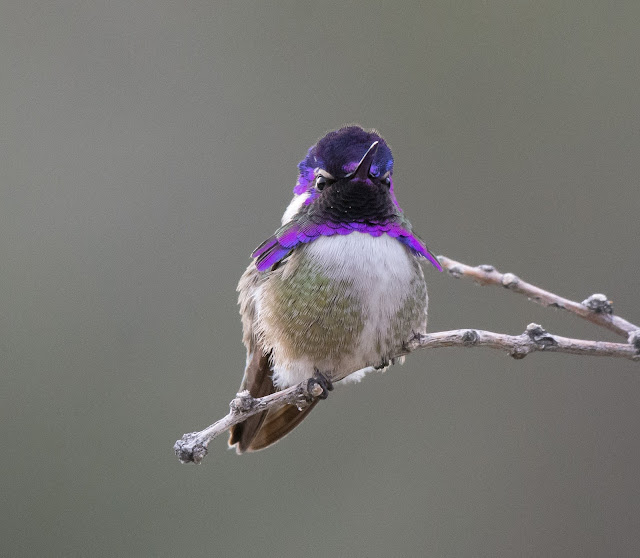While reviewing my photos from this last fall, I found that I had forgotten about some of the photos of hummingbirds that I took and decided a blog post might be in order to show some of the various stages of what some of these marvelous little birds can look like at other times of the year. It is uncommon that one will see the various plumage variances in field guides and on apps. Field guides do not always show the various stage of plumage molt and lighting plays a big factor in seeing the iridescence that is depicted in field guides or apps.
Here in the Phoenix area, we have 2 species that can be found as year-round residents; the very common Anna's Hummingbird and the stunning Costa's Hummingbird. Anna's are by far the most common, but Costa's can be reliably found in the right habitats. We do have the occasional rarities in the winter as well. We have had records of Broad-billed, Rufous, Calliope, and most recently a Broad-tailed Hummingbird that has spent winter in the Phoenix area.
At the beginning of each species, I have included a brief note as to how these 2 species got their names that will hopefully give you a bit of insight on the background of the names of these hummingbirds. Now, let's move on to some photos of them that will show how different they can appear. Lighting plays a lot in how we see them. The males have bright and colorful gorgets, but only when the light is refracted off of them. Many times, all we see is what appears to be a black gorget. When an immature male begins to molt into adult plumage, there is frequently a sprinkling of the iridescence that we can sometime see. With females, there is not as much of a noticeable difference.
Anna's Hummingbird
Anna's Hummingbird was named after Anna Masséna, Princess d'Essling, Duchess of Rivoli, who was the wife of Prince Victor Masséna, the Duke of Rivoli. And if you saw the connection to the name of Rivoli's Hummingbird, then you are correct. Rivoli's Hummingbird got its name from the Duke of Rivoli and the Anna's Hummingbird was named after his wife.
Adult male - Note the light refracting off the crown and left side of throat appear to be goldish/green.
Adult male, but note the red behind the eye and the rest of the gorget and head appear black.
Back looks green in this photo, but note the next photo.
The back appears gold in this photo. All a part of lighting and a good reason to not depend on color all the time for identifying birds.
Female
Female
Female
Adult male
Immature male just beginning to molt.
Same bird as preceding photo, but a different angle.
Immature male, note the magenta colored feathers which is a part of the molting process.
Same bird as preceding photo, different angle.
Immature male, still has a way to to go on its molt.
Costa's Hummingbird
Costa's Hummingbird was named after Louis Marie Panteleon Costa, Marquis de Beau-Regard, who was a Sardinian aristocrat and an accomplished amateur ornithologist.
In this photo gorget appears black.
In this photo, most of the gorget appears black, but note the purple on the tips of the gorget.
An immature male in molt.
The same immature male as above.
Another immature male, and below is the same bird but a different angle.
Rufous Hummingbird
Just this past week I had the pleasure of hosting a Rufous Hummingbird in my back yard for 4 days. It arrived before the first day of spring so technically it visited my yard in the winter. This species is a long distance migrant, wintering in southwestern Mexico and breeding in the Pacific Northwest and all the way through British Columbia and even Alaska. They migrate approximately 2500 miles twice a year. Pretty remarkable for such a tiny bird! Twice before, I had a Rufous Humingbird visit my yard and both visits were in August on their way south and both birds were one-day wonders in my yard and my feeders. This was the first spring migrant that I had and she decided to stay for 4 days! They are notoriously feisty, and she was no exception. She quickly took charge of my back yard and the resident Anna's did not know how to respond. It was quite enjoyable to watch one for a longer period of time than normal.
If you love hummingbirds and you live in Arizona, you have a lot of opportunities to see several species. And if you have a home, putting out hummingbird feeders is a great way to attract them to your yard. Even apartment dwellers can get them to visit a feeder on a balcony. They are remarkable little birds with a lot of energy and personality.

































I'm glad domestic tranquility has been restored to the Masséna household. Of course, the Duke had his trogon all along, but it had to burn when Anna took the lead in the hummingbird sweepstakes.
ReplyDeleteNice images all!
If I remember correctly, i think you are the person that got my into researching this tidbit of info.
DeleteThank for the comments Pete!